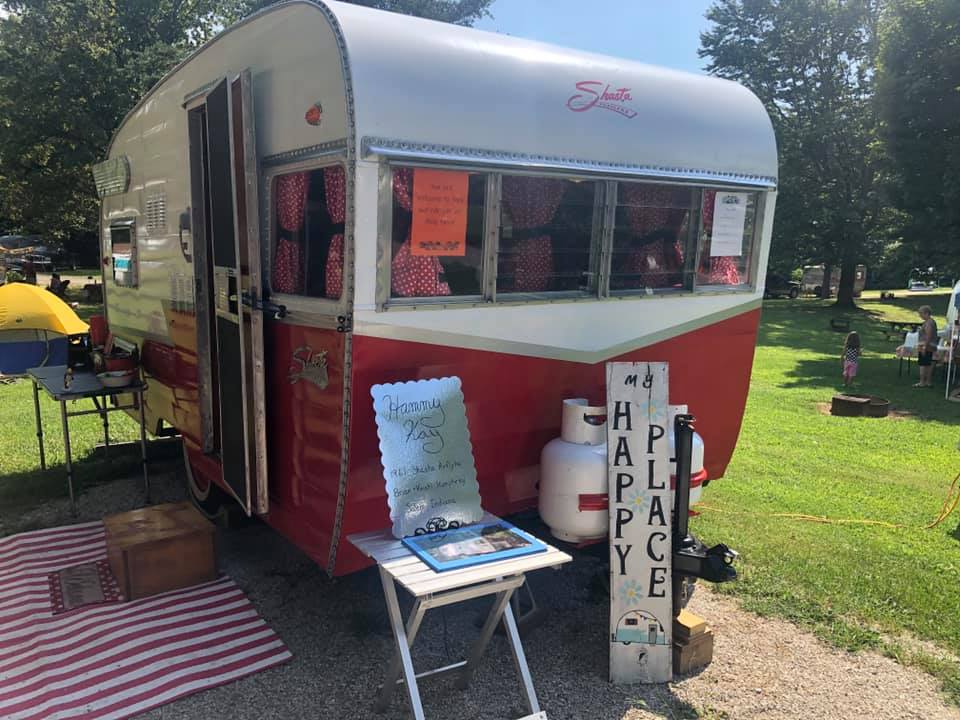
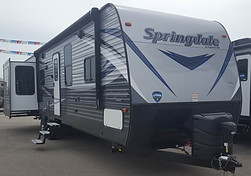
Travel Trailers: This is the number one selling type of RV in the industry. They are towed behind an SUV or Truck and depending on the overall size and weight, some smaller units can be towed by a Ford Expedition, Chevrolet Suburban or similar. The larger rigs can be towed by 1/2 ton, 3/4 ton, 1 ton or larger trucks. It’s important to know your trailer dry weight and the overall weight loaded up before deciding which vehicle you will need to safely tow a travel trailer. It’s also important to note that tow-bars and sway control may also be needed and depends on your trailers overall weight and length. There are many beautiful floor plans available and can sleep 2 people or an entire family. The travel trailer is a great way to enjoy the RV lifestyle on a budget. Some smaller travel trailers are under 10′ long and the larger units can get up to about 40′ with multiple slide outs as options. A travel trailer also gives the user many amenities that someone tent camping wouldn’t have including stoves, refrigerators, couches, recliners and a comfortable bed to name just a few. Travel trailers are great options for many families, however, it’s important to have the proper equipment to pull your rig and take time to learn how to back it up. Before deciding on which Travel Trailer may be best for your family, try to think ahead a couple of years. Most new Travel Trailer owners buy a rig that’s to small for their family and end up trading for a larger unit within a couple of years.
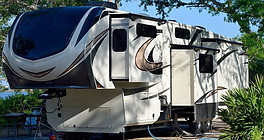
Fifth Wheel: The fifth wheel is a great option for the family looking for the most space in a smaller footprint. The raised forward section of the trailer allows for extra living space above the hitch of the trailer. The bi-level setup allows a trailer manufacturer to design the bedroom in that portion or many will also make this a living room area. Fifth wheels typically are larger than most travel trailers and often include multiple slideouts. As the full time RV lifestyle continues to grow, the fifth wheel is a very popular choice among those families who permanently live in their unit. The fifth wheel trailer attaches to the tow vehicle with a special hitch thats located in the bed of the truck. It’s important to know that depending on the size of the bed of your truck, you may need a slider. Without the use of a slider on a truck with a small bed, the fifth wheel could seriously damage the tow vehicle when making turns. There are many brands available and some of the more popular fifth wheel hitches with or without sliders include: Draw-Tite, Curt and BNW. PullRite offers an automatic slider that is very easy to use but it really depends on your preference. All of the brands mentioned here are very solid names in the towing industry.
Many people believe that towing a fifth wheel trailer is easier than pulling a travel trailer since the hitch is in the bed directly over the rear tires and suspension. This placement is said allow the tow vehicle gain better traction and the driver to have more control of the unit. Pulling a fifth wheel trailer is similar to driving a semi tractor trailer as the larger units will require a wide turning radius. If you are planning on pulling a fifth wheel unit, be sure your truck can handle the extra weight.
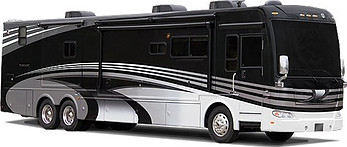 Class A Motorhomes (Gas & Diesel): The Class A motorhome is a high end way to enjoy the RV lifestyle. Many new or newer Class A Motorhomes have a starting cost in excess of $100,000 with a few exceptions dropping below the 6 figures. The frames are usually made using a commercial truck or bus chassis and are very heavy which makes these units some of the worst vehciles when it comes to fuel mileage. Many Class A rigs cruise down the highway while getting less than 10 miles per gallon. With the expensive price tag comes many luxuries that you wouldn’t get with a travel trailer or fifth wheel. If you add a couple of slide out rooms, this could be your next home on wheels.
Class A Motorhomes (Gas & Diesel): The Class A motorhome is a high end way to enjoy the RV lifestyle. Many new or newer Class A Motorhomes have a starting cost in excess of $100,000 with a few exceptions dropping below the 6 figures. The frames are usually made using a commercial truck or bus chassis and are very heavy which makes these units some of the worst vehciles when it comes to fuel mileage. Many Class A rigs cruise down the highway while getting less than 10 miles per gallon. With the expensive price tag comes many luxuries that you wouldn’t get with a travel trailer or fifth wheel. If you add a couple of slide out rooms, this could be your next home on wheels.
The Class A motorhome can have gas or diesel engines and could be up to around 50′ long. The smaller rigs usually run on gas but the larger units generally will have a diesel engine and have obtained a nickname over the years as Diesel Pushers. Many Class A models feature high tech entertainment systems, large kitchens and living rooms along with big bedrooms and bathrooms. There is a learning curve on driving such a large vehicle and don’t forget to bring along your personal vehicle unless you want to unhook your rig everytime you need to head to the campstore.
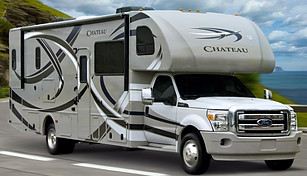
Class C Motorhomes: The Class C motorhome is a camper that similar to the Class A can be driven. Many people believe the Class C is easier to drive because the seats are lower to the ground and is on a truck chassis, so it’s very similar to driving a Ford Superduty or Chevy 3500 truck. A Class C is also more affordable than a Class A in most cases, yet more expensive than most travel trailers and 5th Wheels.
Because of the size of most Class C units, it allows the owner to park the unit and still fit into most campsites. There is nothing worse than arriving at a campground only to find that your rig is to large for any remaining spots. It happens daily for families who drive the larger Class A or Class C units. We recommend that once you find a good spot as you travel, to keep tabs on what sites your rig will fit so you can plan ahead and book your reservation prior to arriving.
Most Class C rigs have a sleeping quarters above the cab with a removable ladder to access that area. This area is great for kids but others feel like the sleeping quarters are to snug and get somewhat clausterphobic. There is also a larger bed for the adults in most of these units and the more luxurious models have slideouts to give the owner more room to move around inside.
A negative for the Class C rigs are their gas mileage. Yes, they are a fun way to vacation and tour the country, but don’t expect more than 15 miles per gallon and you should count on that number actually being alot lower. Some Class C’s get as low as 7 mpg. Yes, I said 7 but keep in mind that includes the actual weather conditions as wind could play a major factor and if you are towing a vehicle behind it, that will also affect your MPG.

Pop Up Campers: Size doesn’t always matter. As traditional travel trailers continue to increase in size and overall weight continues to drop, the pop up camper is quickly becoming a dinosaur. These units were very popular many years ago as a great cost cutting option for families who wanted to enjoy the camping lifestyle but didn’t want to go all the way with a full fledged camper. Cost was not the only reason users chose the pop up camper as many of the larger travel trailers needed larger trucks to pull them due to their weight. Over the years, many of those smaller travel trailers are made of light weight materials which in turn make it much easier to find an SUV or small truck to pull them.
The pop up camper gives its users a very nice camping experience compared to roughing it on the ground in a tent. Many of these tent campers have stoves and small refrigerators in them and some will even have a toilet. The sleeping quarters are on the end of the unit in the tent area that extrudes from the ends of the unit.
There are many advantages of the pop up tent camper as they are easy to pull and help you save gas during the trip. Some of the upper end pop ups can be used in the winter months as well. I don’t expect this type of unit to completely disappear as the minimalist movement continues to grow. A pop up tent camper lets the user spend time in the wild without much effort or costs involved. If you don’t want a full fledged RV but don’t want to sleep in a tent, the pop up camper could be just what you are looking for.
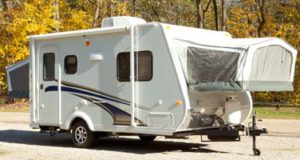
Expandables: What happens when a travel trailer meets up with a pop up camper? Yep, that’s right, you have an expandable camper. You get the best of both worlds and allows families to have a full fledged travel trailer yet not give up space for a bedroom. This is perfect for someone who has a smaller drive way as it allows the user to get a lot more space for their money without taking up to much room in the drive way. The expandable market is small however as these units are not for everyone. The dealers that I have spoken with about expandable campers have noted that they seem to be slow sellers. Although the expandable is a solution for many people with space concerns, the market has yet to fully accept these types of units. Yes, there are families who will eventually buy them but keep in mind that you may have a harder time reselling your unit due to the low demand.
The expandable travel trailer is easy to tow and very compact when not set up, but give you plenty of space once the tent portion is in place. Although we wouldn’t personally recommend an expandable travel trailer, if it’s something that you feel will help you get the space you need to enjoy the RV lifestyle, pick one up and head to the campgrounds.
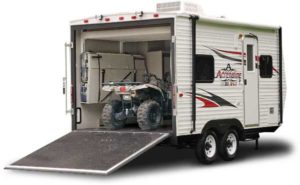 Toy Haulers: A toy hauler is a travel trailer with a ramp door in the rear of the unit that opens up and allows the user to drive a “toy” inside so it can be transported. Although most toy haulers are travel trailers, there are a good number of Class A motorhomes on the road that have the same rear ramp door that opens up for the “toys”. When I say toys, I don’t mean our kids bicycles and other fun stuff, these toys are usually made for adults. Whether it be a golf cart, four wheeler or even a car, if it fits, it rides.
Toy Haulers: A toy hauler is a travel trailer with a ramp door in the rear of the unit that opens up and allows the user to drive a “toy” inside so it can be transported. Although most toy haulers are travel trailers, there are a good number of Class A motorhomes on the road that have the same rear ramp door that opens up for the “toys”. When I say toys, I don’t mean our kids bicycles and other fun stuff, these toys are usually made for adults. Whether it be a golf cart, four wheeler or even a car, if it fits, it rides.
When a toy hauler is not hauling our favorite toys around the country, it can be used as a normal travel trailer. Usually the front of the toy hauler is where the living area would be but depending on how they are designed, some living space could also be in the rear of the trailer. When that’s the case, the furniture or beds are usually collapsible and fold up next to the wall. Some ramps are designed to stay partially off of the ground which when lowered, it gives the user an outdoor deck to enjoy.
Most toy haulers are wider than a traditional travel trailer due to them needing to accommodate a “toy” or other cargo. It’s not uncommon to see an 8’6″ wide unit which is the maximum allowed on most roadways. They also usually have 8′ ceilings which allows for more space to enjoy when you don’t have it full of cargo. Even if you don’t have “toys” or other cargo to take along on your trip, you may still want to consider a toy hauler as the extra wide rooms and tall ceiling give the user a more spacious feel.
If you have questions or comments about this article or simply want to reach out, feel free to email us at: simplyrvlife@gmail.com
